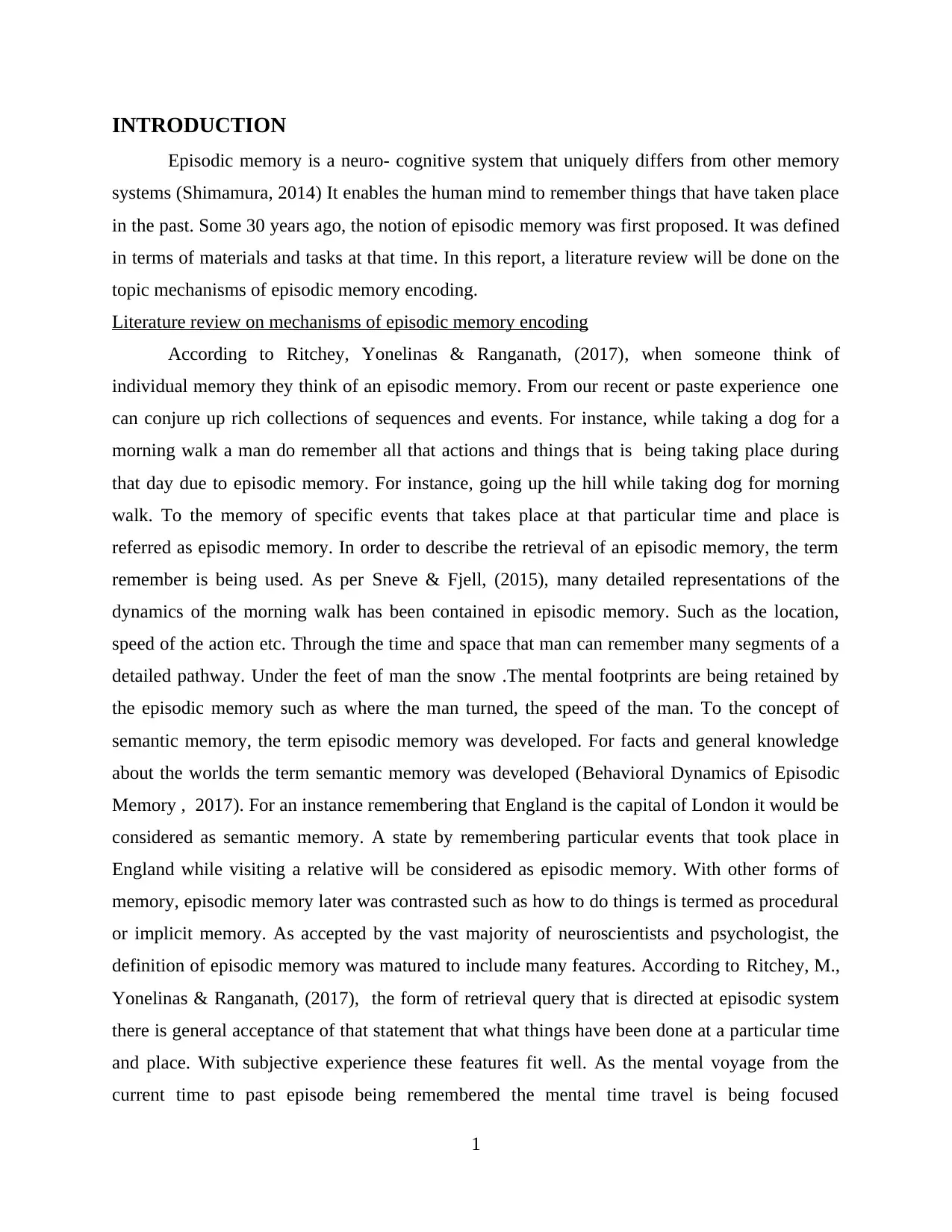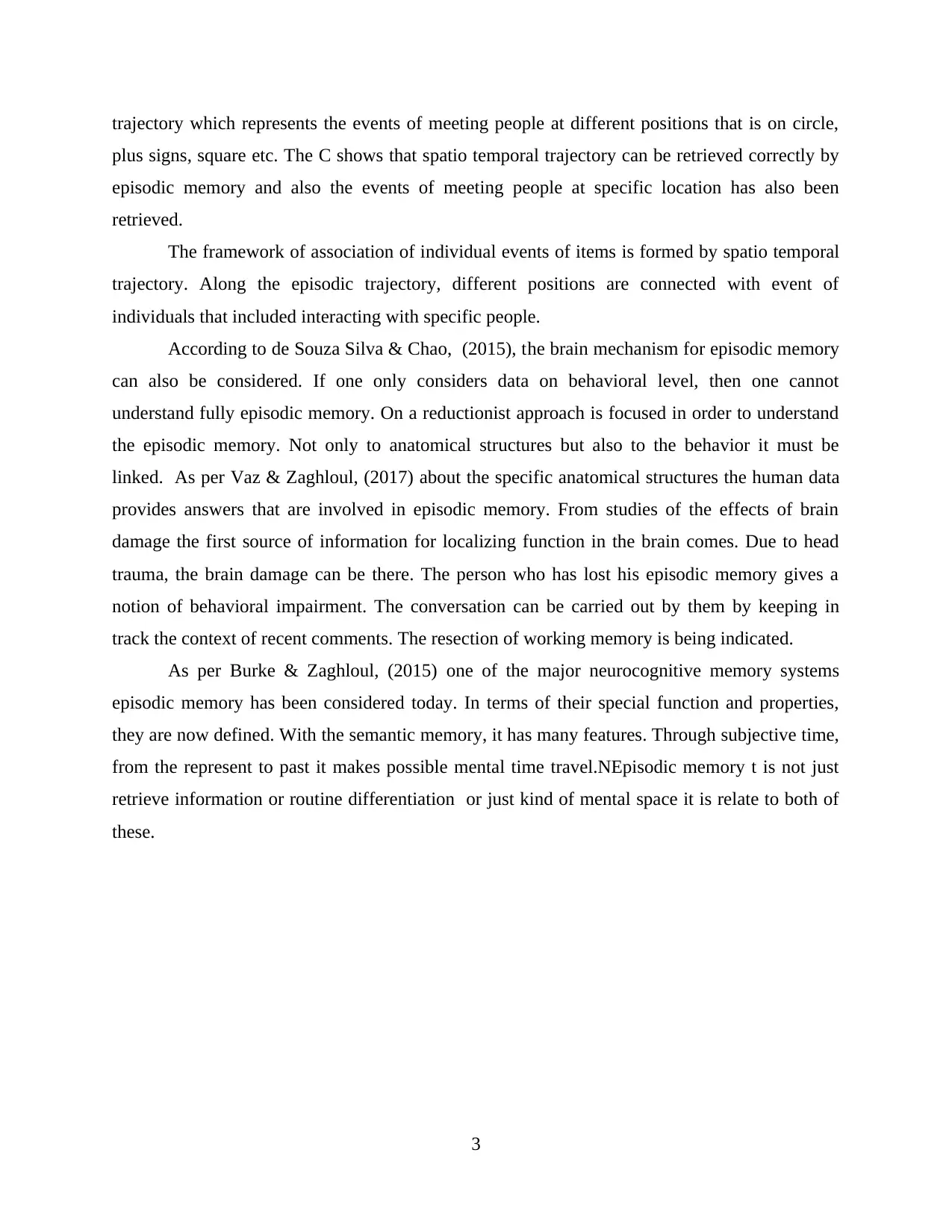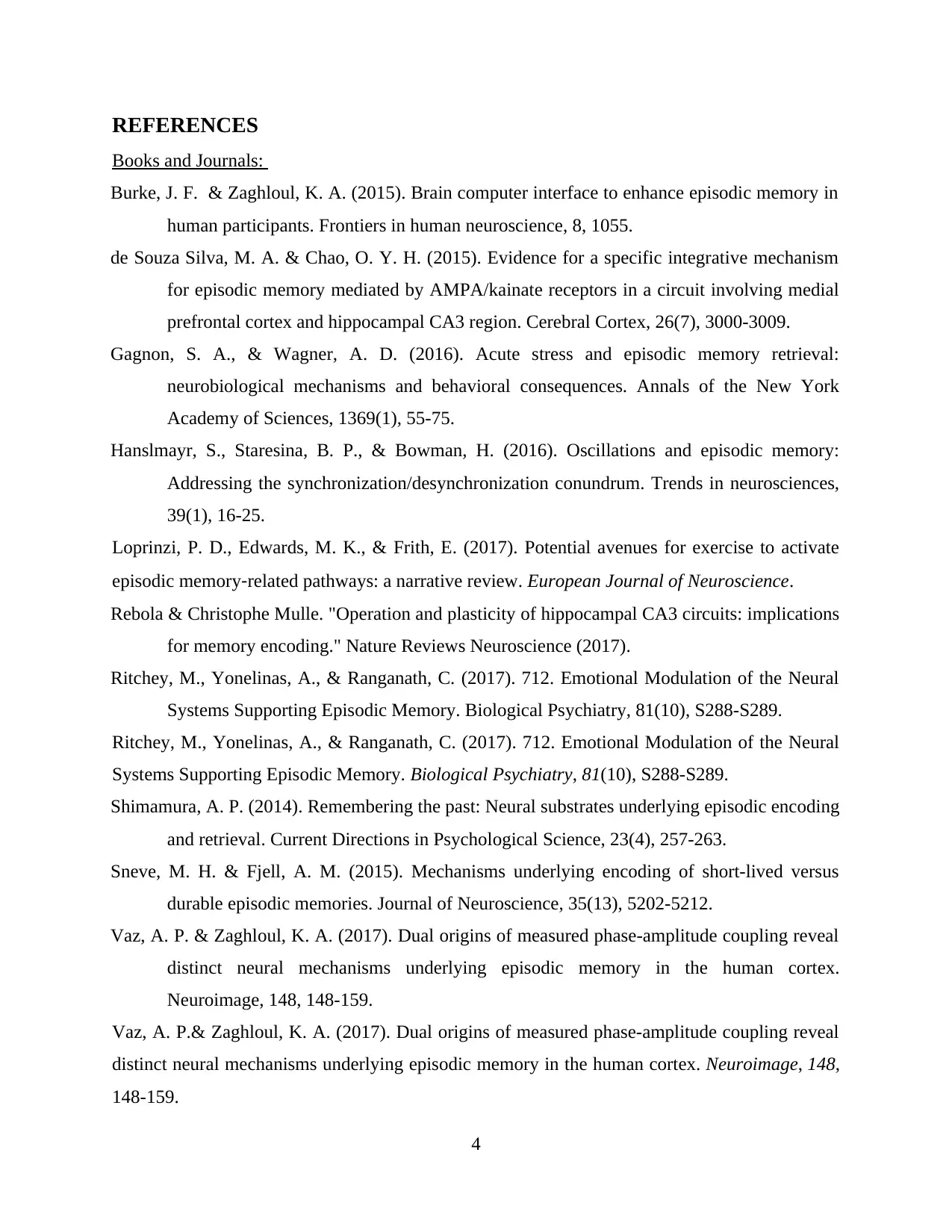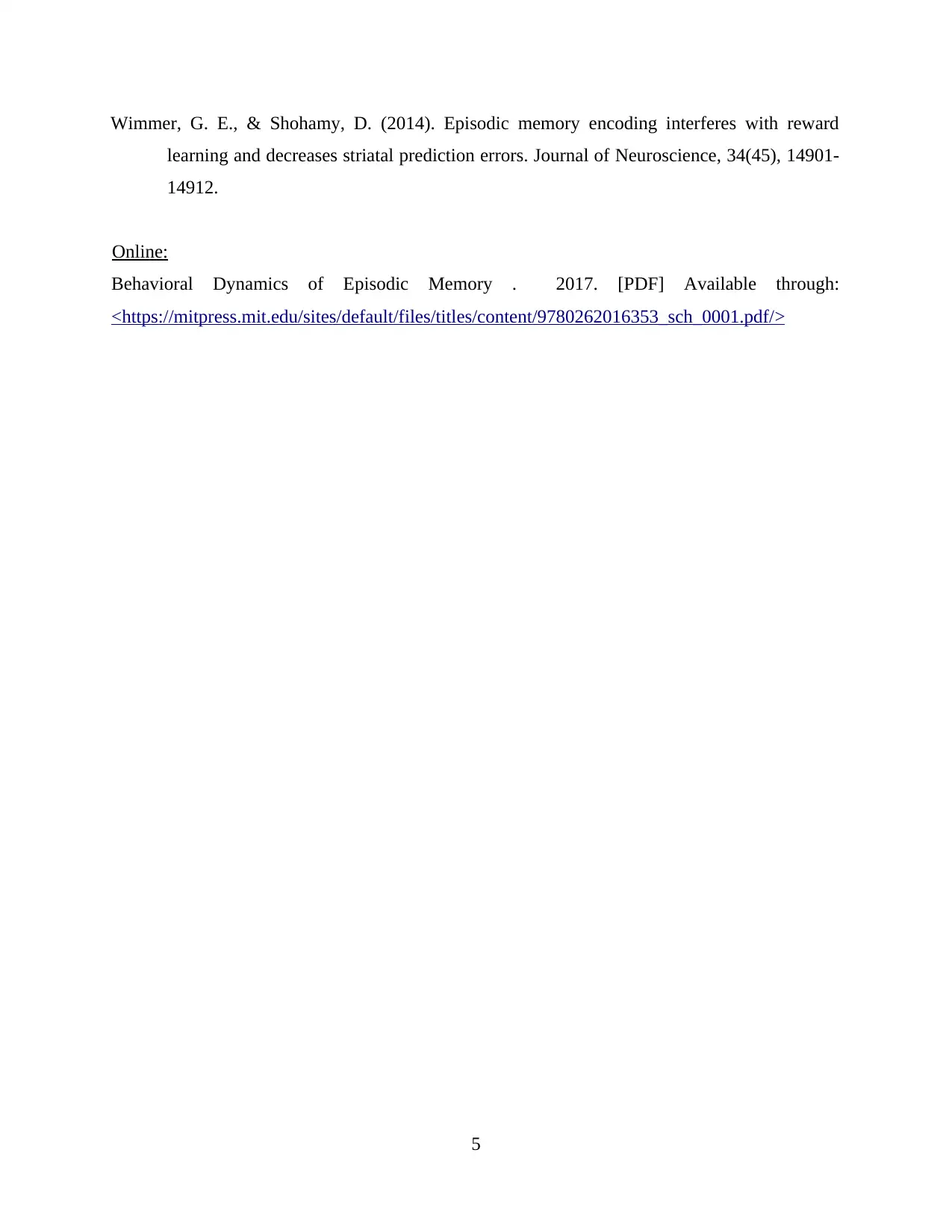Episodic Memory and Neuroscience
VerifiedAdded on 2020/06/05
|7
|1692
|74
AI Summary
This assignment delves into the intricate workings of episodic memory within the brain. It examines the neural mechanisms underlying memory encoding and retrieval, highlighting key brain regions and networks involved. The assignment explores how factors like emotion and exercise can modulate episodic memory function. Furthermore, it investigates the dynamic interplay between episodic memory and other cognitive processes, such as reward learning.
Contribute Materials
Your contribution can guide someone’s learning journey. Share your
documents today.

MECHANISMS OF
EPISODIC MEMORY
ENCODING
EPISODIC MEMORY
ENCODING
Secure Best Marks with AI Grader
Need help grading? Try our AI Grader for instant feedback on your assignments.

Table of Contents
INTRODUCTION...........................................................................................................................1
Literature review on mechanisms of episodic memory encoding..........................................1
REFERENCES ...............................................................................................................................4
INTRODUCTION...........................................................................................................................1
Literature review on mechanisms of episodic memory encoding..........................................1
REFERENCES ...............................................................................................................................4

INTRODUCTION
Episodic memory is a neuro- cognitive system that uniquely differs from other memory
systems (Shimamura, 2014) It enables the human mind to remember things that have taken place
in the past. Some 30 years ago, the notion of episodic memory was first proposed. It was defined
in terms of materials and tasks at that time. In this report, a literature review will be done on the
topic mechanisms of episodic memory encoding.
Literature review on mechanisms of episodic memory encoding
According to Ritchey, Yonelinas & Ranganath, (2017), when someone think of
individual memory they think of an episodic memory. From our recent or paste experience one
can conjure up rich collections of sequences and events. For instance, while taking a dog for a
morning walk a man do remember all that actions and things that is being taking place during
that day due to episodic memory. For instance, going up the hill while taking dog for morning
walk. To the memory of specific events that takes place at that particular time and place is
referred as episodic memory. In order to describe the retrieval of an episodic memory, the term
remember is being used. As per Sneve & Fjell, (2015), many detailed representations of the
dynamics of the morning walk has been contained in episodic memory. Such as the location,
speed of the action etc. Through the time and space that man can remember many segments of a
detailed pathway. Under the feet of man the snow .The mental footprints are being retained by
the episodic memory such as where the man turned, the speed of the man. To the concept of
semantic memory, the term episodic memory was developed. For facts and general knowledge
about the worlds the term semantic memory was developed (Behavioral Dynamics of Episodic
Memory , 2017). For an instance remembering that England is the capital of London it would be
considered as semantic memory. A state by remembering particular events that took place in
England while visiting a relative will be considered as episodic memory. With other forms of
memory, episodic memory later was contrasted such as how to do things is termed as procedural
or implicit memory. As accepted by the vast majority of neuroscientists and psychologist, the
definition of episodic memory was matured to include many features. According to Ritchey, M.,
Yonelinas & Ranganath, (2017), the form of retrieval query that is directed at episodic system
there is general acceptance of that statement that what things have been done at a particular time
and place. With subjective experience these features fit well. As the mental voyage from the
current time to past episode being remembered the mental time travel is being focused
1
Episodic memory is a neuro- cognitive system that uniquely differs from other memory
systems (Shimamura, 2014) It enables the human mind to remember things that have taken place
in the past. Some 30 years ago, the notion of episodic memory was first proposed. It was defined
in terms of materials and tasks at that time. In this report, a literature review will be done on the
topic mechanisms of episodic memory encoding.
Literature review on mechanisms of episodic memory encoding
According to Ritchey, Yonelinas & Ranganath, (2017), when someone think of
individual memory they think of an episodic memory. From our recent or paste experience one
can conjure up rich collections of sequences and events. For instance, while taking a dog for a
morning walk a man do remember all that actions and things that is being taking place during
that day due to episodic memory. For instance, going up the hill while taking dog for morning
walk. To the memory of specific events that takes place at that particular time and place is
referred as episodic memory. In order to describe the retrieval of an episodic memory, the term
remember is being used. As per Sneve & Fjell, (2015), many detailed representations of the
dynamics of the morning walk has been contained in episodic memory. Such as the location,
speed of the action etc. Through the time and space that man can remember many segments of a
detailed pathway. Under the feet of man the snow .The mental footprints are being retained by
the episodic memory such as where the man turned, the speed of the man. To the concept of
semantic memory, the term episodic memory was developed. For facts and general knowledge
about the worlds the term semantic memory was developed (Behavioral Dynamics of Episodic
Memory , 2017). For an instance remembering that England is the capital of London it would be
considered as semantic memory. A state by remembering particular events that took place in
England while visiting a relative will be considered as episodic memory. With other forms of
memory, episodic memory later was contrasted such as how to do things is termed as procedural
or implicit memory. As accepted by the vast majority of neuroscientists and psychologist, the
definition of episodic memory was matured to include many features. According to Ritchey, M.,
Yonelinas & Ranganath, (2017), the form of retrieval query that is directed at episodic system
there is general acceptance of that statement that what things have been done at a particular time
and place. With subjective experience these features fit well. As the mental voyage from the
current time to past episode being remembered the mental time travel is being focused
1

by .However on the contrary note as per Vaz & Zaghloul, (2017), within the past episode itself
does not pay attention on mental time travel. Rather than continuous flow it suggests continuous
flow of retrieval and for each discrete snapshot, it is being suggested that retrieval act is needed.
To the element of personal experience such as memory that man is having about how this dog
lunging towards the cat of neighbor at runs contrary stated by Rebola & Christophe Mulle,
(2017). As stated by Hanslmayr, Staresina & Bowman, (2016), the models of present dynamic of
episodic memory allows to remember a sequence of events as segments of a spatio temporal
trajectory. Other researcher also elaborated further features of episodic memory. The perspective
of this memory is that it consists of point of view of the human retrieving the memory. The short
time section of experience is need to be represented by visual episodic memories as per Wimmer
& Shohamy, (2014). With the model, episodic memory as a spatio temporal trajectory this
connection of short time slice of experience is consistent. Different events that take place in the
similar work environment is remembered with the help of episodic memory as stated by Ritchey,
Yonelinas & Ranganath, (2017). In detail, after few hours or days can be recalled with this type
of memory.
This above represented shows the spatio temporal trajectory through Boston University campus.
In this example, the person encounters with other pole at different position is shown in A .
In the B as given by Gagnon & Wagne, (2016), in gray with symbols shows the encoded
2
does not pay attention on mental time travel. Rather than continuous flow it suggests continuous
flow of retrieval and for each discrete snapshot, it is being suggested that retrieval act is needed.
To the element of personal experience such as memory that man is having about how this dog
lunging towards the cat of neighbor at runs contrary stated by Rebola & Christophe Mulle,
(2017). As stated by Hanslmayr, Staresina & Bowman, (2016), the models of present dynamic of
episodic memory allows to remember a sequence of events as segments of a spatio temporal
trajectory. Other researcher also elaborated further features of episodic memory. The perspective
of this memory is that it consists of point of view of the human retrieving the memory. The short
time section of experience is need to be represented by visual episodic memories as per Wimmer
& Shohamy, (2014). With the model, episodic memory as a spatio temporal trajectory this
connection of short time slice of experience is consistent. Different events that take place in the
similar work environment is remembered with the help of episodic memory as stated by Ritchey,
Yonelinas & Ranganath, (2017). In detail, after few hours or days can be recalled with this type
of memory.
This above represented shows the spatio temporal trajectory through Boston University campus.
In this example, the person encounters with other pole at different position is shown in A .
In the B as given by Gagnon & Wagne, (2016), in gray with symbols shows the encoded
2
Secure Best Marks with AI Grader
Need help grading? Try our AI Grader for instant feedback on your assignments.

trajectory which represents the events of meeting people at different positions that is on circle,
plus signs, square etc. The C shows that spatio temporal trajectory can be retrieved correctly by
episodic memory and also the events of meeting people at specific location has also been
retrieved.
The framework of association of individual events of items is formed by spatio temporal
trajectory. Along the episodic trajectory, different positions are connected with event of
individuals that included interacting with specific people.
According to de Souza Silva & Chao, (2015), the brain mechanism for episodic memory
can also be considered. If one only considers data on behavioral level, then one cannot
understand fully episodic memory. On a reductionist approach is focused in order to understand
the episodic memory. Not only to anatomical structures but also to the behavior it must be
linked. As per Vaz & Zaghloul, (2017) about the specific anatomical structures the human data
provides answers that are involved in episodic memory. From studies of the effects of brain
damage the first source of information for localizing function in the brain comes. Due to head
trauma, the brain damage can be there. The person who has lost his episodic memory gives a
notion of behavioral impairment. The conversation can be carried out by them by keeping in
track the context of recent comments. The resection of working memory is being indicated.
As per Burke & Zaghloul, (2015) one of the major neurocognitive memory systems
episodic memory has been considered today. In terms of their special function and properties,
they are now defined. With the semantic memory, it has many features. Through subjective time,
from the represent to past it makes possible mental time travel.NEpisodic memory t is not just
retrieve information or routine differentiation or just kind of mental space it is relate to both of
these.
3
plus signs, square etc. The C shows that spatio temporal trajectory can be retrieved correctly by
episodic memory and also the events of meeting people at specific location has also been
retrieved.
The framework of association of individual events of items is formed by spatio temporal
trajectory. Along the episodic trajectory, different positions are connected with event of
individuals that included interacting with specific people.
According to de Souza Silva & Chao, (2015), the brain mechanism for episodic memory
can also be considered. If one only considers data on behavioral level, then one cannot
understand fully episodic memory. On a reductionist approach is focused in order to understand
the episodic memory. Not only to anatomical structures but also to the behavior it must be
linked. As per Vaz & Zaghloul, (2017) about the specific anatomical structures the human data
provides answers that are involved in episodic memory. From studies of the effects of brain
damage the first source of information for localizing function in the brain comes. Due to head
trauma, the brain damage can be there. The person who has lost his episodic memory gives a
notion of behavioral impairment. The conversation can be carried out by them by keeping in
track the context of recent comments. The resection of working memory is being indicated.
As per Burke & Zaghloul, (2015) one of the major neurocognitive memory systems
episodic memory has been considered today. In terms of their special function and properties,
they are now defined. With the semantic memory, it has many features. Through subjective time,
from the represent to past it makes possible mental time travel.NEpisodic memory t is not just
retrieve information or routine differentiation or just kind of mental space it is relate to both of
these.
3

REFERENCES
Books and Journals:
Burke, J. F. & Zaghloul, K. A. (2015). Brain computer interface to enhance episodic memory in
human participants. Frontiers in human neuroscience, 8, 1055.
de Souza Silva, M. A. & Chao, O. Y. H. (2015). Evidence for a specific integrative mechanism
for episodic memory mediated by AMPA/kainate receptors in a circuit involving medial
prefrontal cortex and hippocampal CA3 region. Cerebral Cortex, 26(7), 3000-3009.
Gagnon, S. A., & Wagner, A. D. (2016). Acute stress and episodic memory retrieval:
neurobiological mechanisms and behavioral consequences. Annals of the New York
Academy of Sciences, 1369(1), 55-75.
Hanslmayr, S., Staresina, B. P., & Bowman, H. (2016). Oscillations and episodic memory:
Addressing the synchronization/desynchronization conundrum. Trends in neurosciences,
39(1), 16-25.
Loprinzi, P. D., Edwards, M. K., & Frith, E. (2017). Potential avenues for exercise to activate
episodic memory‐related pathways: a narrative review. European Journal of Neuroscience.
Rebola & Christophe Mulle. "Operation and plasticity of hippocampal CA3 circuits: implications
for memory encoding." Nature Reviews Neuroscience (2017).
Ritchey, M., Yonelinas, A., & Ranganath, C. (2017). 712. Emotional Modulation of the Neural
Systems Supporting Episodic Memory. Biological Psychiatry, 81(10), S288-S289.
Ritchey, M., Yonelinas, A., & Ranganath, C. (2017). 712. Emotional Modulation of the Neural
Systems Supporting Episodic Memory. Biological Psychiatry, 81(10), S288-S289.
Shimamura, A. P. (2014). Remembering the past: Neural substrates underlying episodic encoding
and retrieval. Current Directions in Psychological Science, 23(4), 257-263.
Sneve, M. H. & Fjell, A. M. (2015). Mechanisms underlying encoding of short-lived versus
durable episodic memories. Journal of Neuroscience, 35(13), 5202-5212.
Vaz, A. P. & Zaghloul, K. A. (2017). Dual origins of measured phase-amplitude coupling reveal
distinct neural mechanisms underlying episodic memory in the human cortex.
Neuroimage, 148, 148-159.
Vaz, A. P.& Zaghloul, K. A. (2017). Dual origins of measured phase-amplitude coupling reveal
distinct neural mechanisms underlying episodic memory in the human cortex. Neuroimage, 148,
148-159.
4
Books and Journals:
Burke, J. F. & Zaghloul, K. A. (2015). Brain computer interface to enhance episodic memory in
human participants. Frontiers in human neuroscience, 8, 1055.
de Souza Silva, M. A. & Chao, O. Y. H. (2015). Evidence for a specific integrative mechanism
for episodic memory mediated by AMPA/kainate receptors in a circuit involving medial
prefrontal cortex and hippocampal CA3 region. Cerebral Cortex, 26(7), 3000-3009.
Gagnon, S. A., & Wagner, A. D. (2016). Acute stress and episodic memory retrieval:
neurobiological mechanisms and behavioral consequences. Annals of the New York
Academy of Sciences, 1369(1), 55-75.
Hanslmayr, S., Staresina, B. P., & Bowman, H. (2016). Oscillations and episodic memory:
Addressing the synchronization/desynchronization conundrum. Trends in neurosciences,
39(1), 16-25.
Loprinzi, P. D., Edwards, M. K., & Frith, E. (2017). Potential avenues for exercise to activate
episodic memory‐related pathways: a narrative review. European Journal of Neuroscience.
Rebola & Christophe Mulle. "Operation and plasticity of hippocampal CA3 circuits: implications
for memory encoding." Nature Reviews Neuroscience (2017).
Ritchey, M., Yonelinas, A., & Ranganath, C. (2017). 712. Emotional Modulation of the Neural
Systems Supporting Episodic Memory. Biological Psychiatry, 81(10), S288-S289.
Ritchey, M., Yonelinas, A., & Ranganath, C. (2017). 712. Emotional Modulation of the Neural
Systems Supporting Episodic Memory. Biological Psychiatry, 81(10), S288-S289.
Shimamura, A. P. (2014). Remembering the past: Neural substrates underlying episodic encoding
and retrieval. Current Directions in Psychological Science, 23(4), 257-263.
Sneve, M. H. & Fjell, A. M. (2015). Mechanisms underlying encoding of short-lived versus
durable episodic memories. Journal of Neuroscience, 35(13), 5202-5212.
Vaz, A. P. & Zaghloul, K. A. (2017). Dual origins of measured phase-amplitude coupling reveal
distinct neural mechanisms underlying episodic memory in the human cortex.
Neuroimage, 148, 148-159.
Vaz, A. P.& Zaghloul, K. A. (2017). Dual origins of measured phase-amplitude coupling reveal
distinct neural mechanisms underlying episodic memory in the human cortex. Neuroimage, 148,
148-159.
4

Wimmer, G. E., & Shohamy, D. (2014). Episodic memory encoding interferes with reward
learning and decreases striatal prediction errors. Journal of Neuroscience, 34(45), 14901-
14912.
Online:
Behavioral Dynamics of Episodic Memory . 2017. [PDF] Available through:
<https://mitpress.mit.edu/sites/default/files/titles/content/9780262016353_sch_0001.pdf/>
5
learning and decreases striatal prediction errors. Journal of Neuroscience, 34(45), 14901-
14912.
Online:
Behavioral Dynamics of Episodic Memory . 2017. [PDF] Available through:
<https://mitpress.mit.edu/sites/default/files/titles/content/9780262016353_sch_0001.pdf/>
5
1 out of 7
Related Documents
Your All-in-One AI-Powered Toolkit for Academic Success.
+13062052269
info@desklib.com
Available 24*7 on WhatsApp / Email
![[object Object]](/_next/static/media/star-bottom.7253800d.svg)
Unlock your academic potential
© 2024 | Zucol Services PVT LTD | All rights reserved.
